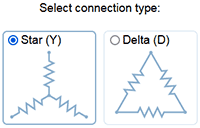| www.tmatlantic.com
Test & Soldering Equipment On-line Store |
|
D.E.V.I.C.E. (Wiki)Calculators Services |
|||||
Filter by first letter
|
How to Calculate Current in a Three-Phase System? A Simple Calculator for Electricians
Three-phase current is the backbone of electrical power supply in industrial, commercial buildings, and many other areas where high power and efficiency are required. Understanding how to calculate the fundamental parameters of three-phase circuits, such as current, power, and voltage, is crucial for any electrician or electrical engineer. In this article, we will explore the key aspects of calculating current in a three-phase system and introduce an easy-to-use tool — the 3 Phase Calculator from TMATLANTIC, which significantly simplifies this process. Basics of Three-Phase CurrentFig. 1. Three-Phase Current A three-phase system consists of three alternating current sources with the same frequency and amplitude but with a phase shift of 120 degrees relative to each other (fig. 1). This provides a more even and powerful energy transfer compared to a single-phase system. Three-phase systems can be connected in two main configurations:
Why is Calculating Current Important?
Formulas for Calculating CurrentDepending on known parameters:
Where:
Example of Current CalculationCalculate the current drawn by a 15 kW three-phase motor at 400 V and power factor 0.8:
Using the 3 Phase Calculator by TMATLANTICUse the online calculator to quickly determine values by entering the known parameters. No need for manual calculation. Additional Useful Information
ConclusionCalculating current in a three-phase system is a critical skill for electricians. Tools like TMATLANTIC’s 3 Phase Calculator simplify the process, ensuring accuracy and safety in electrical system design and troubleshooting. 3 phase calculator - a simple online tool for electricians |
Site mapPrivacy policyTerms of Use & Store PoliciesHow to BuyShippingPayment




|



























